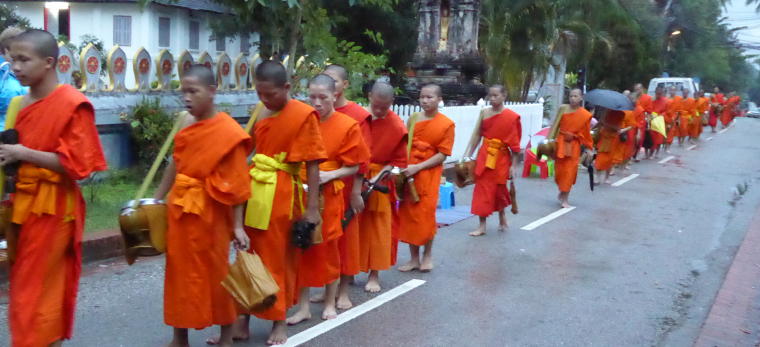|
December 2, 2015
 This
morning we flew from Bangkok to Luang Prabang, Laos. It was a 2
hour flight on a prop plane. We were met in Laos by a local guide,
Chermous (we called him Cheers) who will be with us throughout Laos.
Luang Prabang was the ancient royal capital of Laos. It is recognized
as a UNESCO World Heritage Site. Flying in we could see green mountains
all around - a pleasant change from the flat terrain of our previously
visited cities. And it was about 10 degrees cooler here with lower
humidity. This
morning we flew from Bangkok to Luang Prabang, Laos. It was a 2
hour flight on a prop plane. We were met in Laos by a local guide,
Chermous (we called him Cheers) who will be with us throughout Laos.
Luang Prabang was the ancient royal capital of Laos. It is recognized
as a UNESCO World Heritage Site. Flying in we could see green mountains
all around - a pleasant change from the flat terrain of our previously
visited cities. And it was about 10 degrees cooler here with lower
humidity.
Luang Prabang is a quaint town along the Mekong River with many
19th century French Colonial villas mixed with more traditional
Lao-style homes.  Buses
are not allowed in the downtown area. Local transportation is on
three wheeled tuk-tuks or on motor bikes. When we got near the city,
we were transferred onto tuk-tuks and taken to lunch and then to
the Sada Hotel where our luggage awaited us in our rooms. This is
another boutique style hotel with only 2 stories per building in
a garden setting. The rooms were spacious with the largest bed we've
ever seen and beautiful teak wood floors and ceilings. Buses
are not allowed in the downtown area. Local transportation is on
three wheeled tuk-tuks or on motor bikes. When we got near the city,
we were transferred onto tuk-tuks and taken to lunch and then to
the Sada Hotel where our luggage awaited us in our rooms. This is
another boutique style hotel with only 2 stories per building in
a garden setting. The rooms were spacious with the largest bed we've
ever seen and beautiful teak wood floors and ceilings.
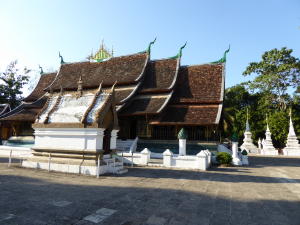 In
the afternoon we went by tuk-tuk to the royal temple Wat Xieng Thong.
It was originally built of wood in 1560 but was reconstructed in
brick and stucco following a fire in the late 19th century. In
the afternoon we went by tuk-tuk to the royal temple Wat Xieng Thong.
It was originally built of wood in 1560 but was reconstructed in
brick and stucco following a fire in the late 19th century.
 Next
to it was the House of the Funeral Carriage. This building contains
a huge golden carriage with golden urns that hold the ashes of the
last king and queen. It was so big it was impossible to get a photo
of the whole thing. Even as impressive as the carriage and urns
were, so were the walls of the house which held pictures done in
glass imported from Japan. They tell the story of the daily lives
of the Lao people and their king and queen. Next
to it was the House of the Funeral Carriage. This building contains
a huge golden carriage with golden urns that hold the ashes of the
last king and queen. It was so big it was impossible to get a photo
of the whole thing. Even as impressive as the carriage and urns
were, so were the walls of the house which held pictures done in
glass imported from Japan. They tell the story of the daily lives
of the Lao people and their king and queen.
 In
the evening we walked through the Night Market on the main street
in the old town area. This is set up every night with vendors selling
locally made handicrafts, clothing and accessories. It was a very
colorful site and interesting to see them setting up their stalls.
We did buy a couple things and were glad that everyone was happy
to take American money. In
the evening we walked through the Night Market on the main street
in the old town area. This is set up every night with vendors selling
locally made handicrafts, clothing and accessories. It was a very
colorful site and interesting to see them setting up their stalls.
We did buy a couple things and were glad that everyone was happy
to take American money.
December 3, 2015
 This
morning we went by tuk-tuk to visit a local village and learn about
their paper and textile making traditions. First we learned how
they make silk, starting from the moths that lay eggs to the worms
eating the mulberry leaves and the larvae from which they get the
silk fiber. This
morning we went by tuk-tuk to visit a local village and learn about
their paper and textile making traditions. First we learned how
they make silk, starting from the moths that lay eggs to the worms
eating the mulberry leaves and the larvae from which they get the
silk fiber. 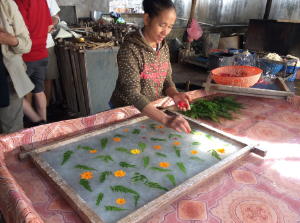 They
also make paper from the mulberry tree bark. We watched a woman
create a design on a frame filled with the mashed up bark and water.
This is then set to dry to create the paper. We even got to try
our hands at a design! They
also make paper from the mulberry tree bark. We watched a woman
create a design on a frame filled with the mashed up bark and water.
This is then set to dry to create the paper. We even got to try
our hands at a design!
 From
the village we embarked on a cruise on the Mekong River. It is one
of the longest rivers in the world, starting in Tibet and running
down to the China Sea. It supports some 90 million people who produce
54,000 square miles of rice every year. The river is also home to
many species of giant fish, including 600 pound catfish! We stopped
along the river to a rural village known for producing a local rice
whiskey. From
the village we embarked on a cruise on the Mekong River. It is one
of the longest rivers in the world, starting in Tibet and running
down to the China Sea. It supports some 90 million people who produce
54,000 square miles of rice every year. The river is also home to
many species of giant fish, including 600 pound catfish! We stopped
along the river to a rural village known for producing a local rice
whiskey.  We
got to taste (and purchase) both the 100 proof variety and the 15
and 30 proof. The latter tasted like sweet wine. We
got to taste (and purchase) both the 100 proof variety and the 15
and 30 proof. The latter tasted like sweet wine.
We continued up the river to the Pak Ou Cave. 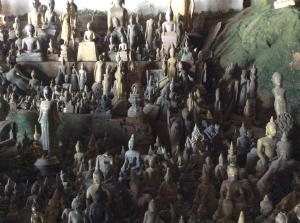 This
cave contains over 5000 Buddha statues. Every year starting in the
16th century until 1975, the king and people from Luang Prabang
made a pilgrimage to the caves as part of the New Year religious
observances. The king commissioned artisans to create images of
Buddha to place in the cave. This
cave contains over 5000 Buddha statues. Every year starting in the
16th century until 1975, the king and people from Luang Prabang
made a pilgrimage to the caves as part of the New Year religious
observances. The king commissioned artisans to create images of
Buddha to place in the cave.
After our visit to the cave, we were served lunch on board the
boat while cruising back down the river to our starting point. What
a wonderful and interesting day.
December 4, 2015
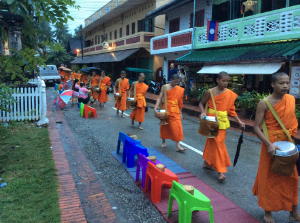 Today
was another very intersting one. We had a 5:15 am wake up call so
we could participate in the ancient Buddhist tradition of alms giving
to the local monks. Each morning hundreds of monks file solemnly
and single file through the streets of Luang Prabang collecting
food offerings from the citizens. In turn, the citizens receive
prayers for their families and friends. We sat on small stools and
were given baskets of sticky rice to spoon into the monk's buckets
as they filed past. Although this was the dry season, it started
to rain last night and it continued all day today. Fortunately,
our hotel provided each room with large umbrellas. Juggling the
umbrella, camera and dolling out rice was quite a feat! Today
was another very intersting one. We had a 5:15 am wake up call so
we could participate in the ancient Buddhist tradition of alms giving
to the local monks. Each morning hundreds of monks file solemnly
and single file through the streets of Luang Prabang collecting
food offerings from the citizens. In turn, the citizens receive
prayers for their families and friends. We sat on small stools and
were given baskets of sticky rice to spoon into the monk's buckets
as they filed past. Although this was the dry season, it started
to rain last night and it continued all day today. Fortunately,
our hotel provided each room with large umbrellas. Juggling the
umbrella, camera and dolling out rice was quite a feat!
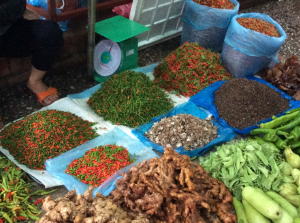 What
we really like about OAT is they believe in not only teaching you
about the cultures of the places you visit, but having hands on
experiences. After the alms giving, we visited an outdoor market
to join locals and have a typical Laotian breakfast. This consisted
of some "doughnuts" made of fried sticky rice and some
noodle soups. All very tasty. What
we really like about OAT is they believe in not only teaching you
about the cultures of the places you visit, but having hands on
experiences. After the alms giving, we visited an outdoor market
to join locals and have a typical Laotian breakfast. This consisted
of some "doughnuts" made of fried sticky rice and some
noodle soups. All very tasty. 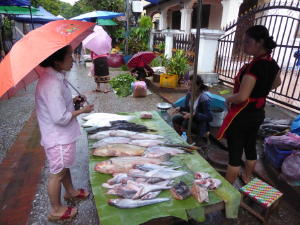 Afterwards
we were each given an ingredient to purchase at the market using
the Lao language. We were given the correct amount of Lao money
so the vendor would know how much of the ingredient to give us.
Ours turned out to be rice noodles. It was kind of fun - like being
on the Amazing Race! The ingredients were to be used later at our
home hosted lunch. Afterwards
we were each given an ingredient to purchase at the market using
the Lao language. We were given the correct amount of Lao money
so the vendor would know how much of the ingredient to give us.
Ours turned out to be rice noodles. It was kind of fun - like being
on the Amazing Race! The ingredients were to be used later at our
home hosted lunch.
We then continued through the market looking at all the native
produce and food products, mingling with the locals as they purchased
their groceries for the day.
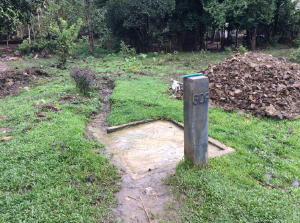 We
then went by bus about a 45 minute drive up into the mountains to
visit a village and school. This village has been supported by the
Grand Circle Foundation (GCF). Grand Circle is the parent company
of OAT and a portion of the profits from every trip goes to the
GCF. Originally the people in the village had to walk down to the
Mekong River to get water. GCF built a pipeline from the mountains
and brought fresh water to the village. They also laid down a concrete
walkway through the village to the school. Otherwise the children
would have to trudge through the mud to get there when it rained.
We were really appreciative of that walkway today because even with
it, there was mud flowing onto it with the rain. I can't imagine
what it would be like during the rainy season. We
then went by bus about a 45 minute drive up into the mountains to
visit a village and school. This village has been supported by the
Grand Circle Foundation (GCF). Grand Circle is the parent company
of OAT and a portion of the profits from every trip goes to the
GCF. Originally the people in the village had to walk down to the
Mekong River to get water. GCF built a pipeline from the mountains
and brought fresh water to the village. They also laid down a concrete
walkway through the village to the school. Otherwise the children
would have to trudge through the mud to get there when it rained.
We were really appreciative of that walkway today because even with
it, there was mud flowing onto it with the rain. I can't imagine
what it would be like during the rainy season.
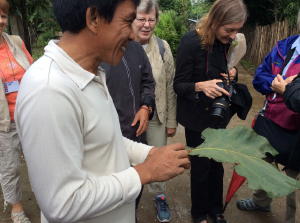 We
were met by the local chief of the village. In order to be chief,
you must be a 3rd generation Communist. Laos is a communist country
but has an elected president. Since there is only one party - Communist
- the president will be a Communist! However, people are free to
own property and businesses. The chief showed us around his village,
with our guide translating. The chief showed us a teak leaf which,
when rubbed, produces a red stain that is used to dye silk. We
were met by the local chief of the village. In order to be chief,
you must be a 3rd generation Communist. Laos is a communist country
but has an elected president. Since there is only one party - Communist
- the president will be a Communist! However, people are free to
own property and businesses. The chief showed us around his village,
with our guide translating. The chief showed us a teak leaf which,
when rubbed, produces a red stain that is used to dye silk.
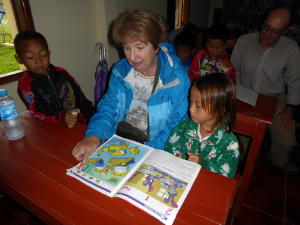 Our
next stop was the school where one teacher teaches 1st and 2nd graders.
He teaches them Lao language, math, hygiene, manners and singing.
We sat with the children as they learned the Lao alphabet. Then
it was our turn to teach them some English words like eye, nose,
etc. Our
next stop was the school where one teacher teaches 1st and 2nd graders.
He teaches them Lao language, math, hygiene, manners and singing.
We sat with the children as they learned the Lao alphabet. Then
it was our turn to teach them some English words like eye, nose,
etc.  After
our visit to the school, we were met by the Shaman of the local
Hmong hill tribe. We learned a little about them and the Shaman
played a couple of their instruments. The religion of the Hmong
tribe is Animist. They supported Americans during the war and their
relationship with communist authorities is strained. After
our visit to the school, we were met by the Shaman of the local
Hmong hill tribe. We learned a little about them and the Shaman
played a couple of their instruments. The religion of the Hmong
tribe is Animist. They supported Americans during the war and their
relationship with communist authorities is strained.
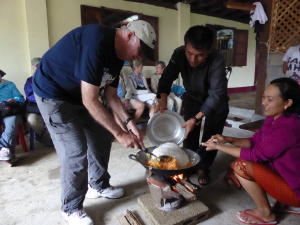 We
then went back to the house of the chief and his wife where we helped
prepare the lunch with the ingredients we had purchased at the market.
One by one we poured our ingredients into a huge wok which was heated
over a wood fire. There were all kinds of vegetables and our noodles,
along with some garlic and cilantro and soy sauce. A very delicious
stir fry. We
then went back to the house of the chief and his wife where we helped
prepare the lunch with the ingredients we had purchased at the market.
One by one we poured our ingredients into a huge wok which was heated
over a wood fire. There were all kinds of vegetables and our noodles,
along with some garlic and cilantro and soy sauce. A very delicious
stir fry.
 But
it turned out that was just the appetizer. The chief's wife had
prepared the rest of the lunch which included soup, fish cooked
in banana leaves and brown sticky rice. Needless to say we were
stuffed. But
it turned out that was just the appetizer. The chief's wife had
prepared the rest of the lunch which included soup, fish cooked
in banana leaves and brown sticky rice. Needless to say we were
stuffed.
So despite the rain, we had a very interesting and informative
day experiencing the life of the local people. Here's some other
interesting facts about Laos. It is 75% Buddhist, 30% other - mostly
Animist. Many people actually practice both! When a man wants to
marry, either arranged or otherwise, he must pay the wife's family
a dowry. The amount is dependent on the beauty of the girl, her
abilities to cook, weave, etc. It is negotiated between the sets
of parents. If the man cannot pay, he goes to live with her parents
and works for them until he has enough money. The primary industry
is agriculture so the work is in the father-in-law's fields.
December 5, 2015
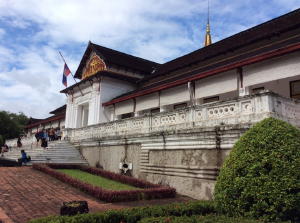 We
spent our final morning in Luang Prabang visiting the Royal Palace
Museum. It was built in 1904-09 during the reign of the last king
of Laos, King Sisavang Vong, and served as his palace. Today it
is a museum where you can see the royal throne and other artifacts
as well as his living quarters. No cameras were allowed in the museum
so there are no photos of the inside. We
spent our final morning in Luang Prabang visiting the Royal Palace
Museum. It was built in 1904-09 during the reign of the last king
of Laos, King Sisavang Vong, and served as his palace. Today it
is a museum where you can see the royal throne and other artifacts
as well as his living quarters. No cameras were allowed in the museum
so there are no photos of the inside.
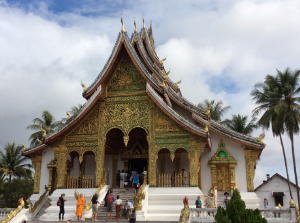 The
other building on the palace grounds was a temple housing a pure
gold Buddha from the 1st century. Again, no photos of the Buddha
itself but it was a beautiful building. The building was built in
1969 and the Buddha moved there from the Royal Palace. The
other building on the palace grounds was a temple housing a pure
gold Buddha from the 1st century. Again, no photos of the Buddha
itself but it was a beautiful building. The building was built in
1969 and the Buddha moved there from the Royal Palace.
We then took a short flight to Vientiane, the capital of Laos.
To read about our time in Vientiane, go to Vientiane
newsletter.
To view more photos from our trip to Luang Prabang, please go to
Luang Prabang Photo Gallery.
Home
Locations Visited Photos Map
Contact Us
|
